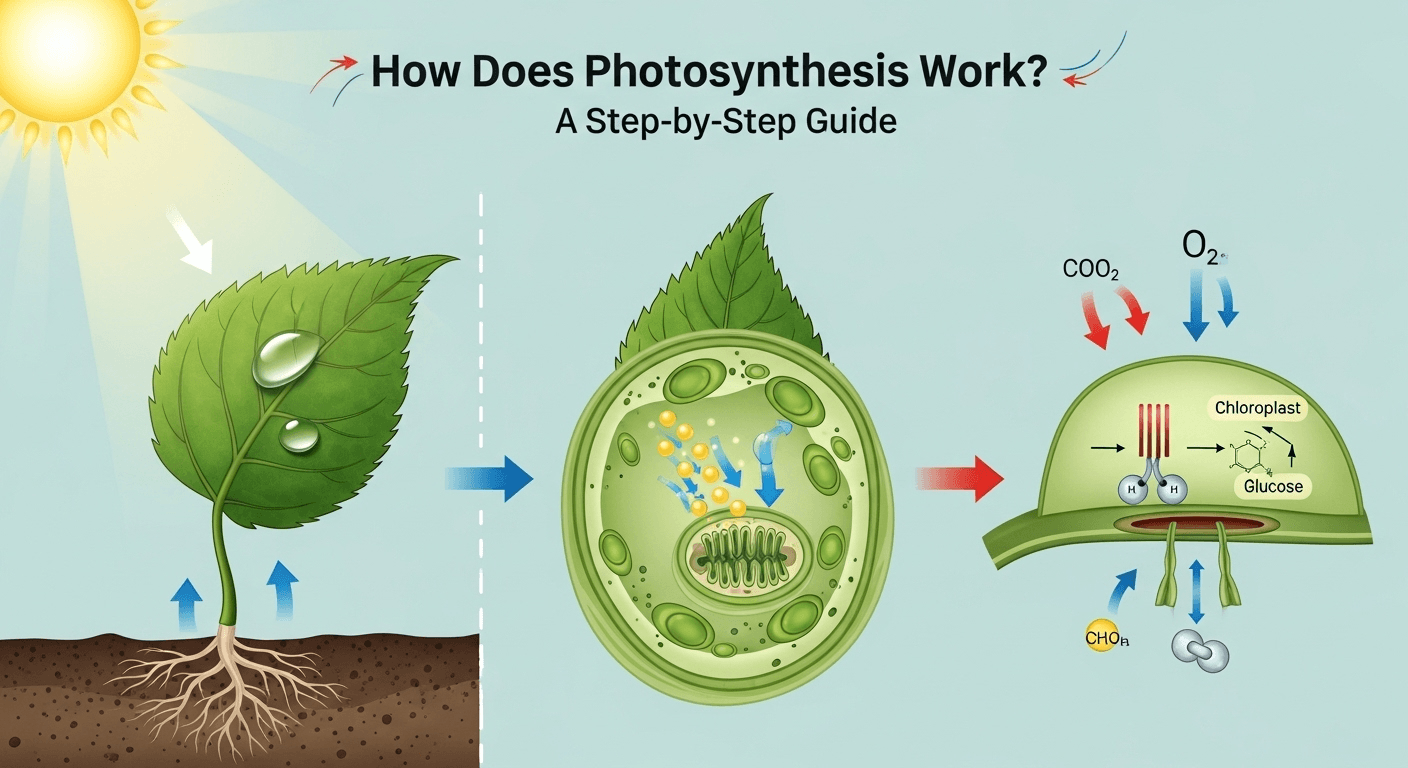Have you ever wondered how a tiny seed can grow into a towering tree, or how the air we breathe gets replenished with life-giving oxygen? The answer to these profound questions lies in a single, elegant biological process: photosynthesis. It is the silent, constant miracle that powers nearly all life on Earth, converting simple sunlight into the chemical energy that fuels ecosystems. Understanding this process is not just for botanists; it's for anyone curious about the fundamental workings of our planet. This guide is designed to explain how does photosynthesis work step by step, breaking down this complex sequence into understandable parts, from the initial capture of a sunbeam to the final creation of a sugar molecule. What is Photosynthesis? The Foundation of Life Photosynthesis is arguably the most important biochemical process on Earth. In its simplest terms, it is the method used by plants, algae, and some bacteria (known as autotrophs) to convert light energy into chemical energy. This chemical energy is then stored in the bonds of carbohydrate molecules, such as glucose (sugar), which the organism can use for fuel. The process uses sunlight, water, and carbon dioxide as its raw materials and releases oxygen as a vital by-product. It is the primary pathway through which energy enters our biosphere, forming the base of almost every food chain. The grand importance of this process cannot be overstated. Every bite of food you eat, whether it's a vegetable, a fruit, or meat from an animal that ate plants, traces its energy back to photosynthesis. The oxygen in our atmosphere, essential for the respiration of nearly all complex life, including humans, is continuously produced by photosynthetic organisms. This delicate balance, where the waste product of one process (oxygen from photosynthesis) is the essential input for another (respiration), illustrates the deep interconnectedness of life on our planet. Ultimately, photosynthesis is a story of transformation. It takes inorganic compounds—water (H₂O) from the soil and carbon dioxide (CO₂) from the air—and, using the boundless energy of the sun, forges them into an organic molecule, glucose (C₆H₁₂O₆). This glucose molecule is a versatile packet of energy, ready to be used by the plant for growth, repair, and reproduction. The process is a testament to nature's efficiency, creating the very foundation of biological energy, structure, and the air we breathe from the most basic of ingredients. The Essential Ingredients: Reactants of Photosynthesis Before any process can begin, it needs its raw materials. Photosynthesis is no different. It relies on three crucial "ingredients" or reactants from the environment to kickstart the energy conversion process. These components are sourced by the plant through specialized structures, each playing an indispensable role. Without a consistent supply of sunlight, water, and carbon dioxide, the entire photosynthetic engine would grind to a halt, underscoring their collective importance. Sunlight: The Ultimate Energy Source Sunlight is the primary driver of photosynthesis. It is a form of electromagnetic radiation, composed of tiny packets of energy called photons. Plants have evolved sophisticated mechanisms to capture these photons, specifically those within the visible light spectrum. While we see sunlight as white, it is actually a rainbow of different colors, each with a different wavelength and energy level. Plant pigments, primarily chlorophyll, are especially good at absorbing light from the blue-violet and red-orange parts of the spectrum, while reflecting green light, which is why plants appear green to our eyes. This captured light energy is not used directly to build sugar. Instead, its first job is to energize electrons within the plant's pigment molecules. This initial "excitation" of electrons is the critical first step that converts light energy into a temporary form of chemical energy. Think of it like using a solar panel to charge a battery; the sunlight provides the initial power, which is then stored in a more usable format. In photosynthesis, this "battery" comes in the form of molecules like ATP and NADPH, which will be used later to power the construction of sugar. Carbon Dioxide (CO₂): The Carbon Backbone If sunlight is the energy, carbon dioxide is the building block. CO₂ is a gas present in the Earth's atmosphere, and it provides the carbon atoms necessary to construct carbohydrate molecules like glucose (C₆H₁₂O₆). Plants "breathe in" carbon dioxide through tiny pores on the surface of their leaves, flowers, or stems called stomata. These stomata can open and close to regulate the exchange of gases and control water loss. When the stomata are open, CO₂ diffuses from the atmosphere into the air spaces within the leaf, eventually reaching the cells where photosynthesis occurs. The carbon atoms from CO₂ are incorporated into organic molecules in a process known as carbon fixation. This is the cornerstone of the second major stage of photosynthesis, the Calvin Cycle. Essentially, the plant takes the inorganic carbon from the air and "fixes" it into a stable, organic form. This act is the very essence of creating biomass—the physical substance of the plant—out of thin air. It is a remarkable feat of chemistry that forms the basis for all organic matter in the food web. Water (H₂O): The Electron Donor Water is the third critical reactant, and it serves multiple functions. Primarily, water is absorbed from the soil through the plant's root system and transported up to the leaves through a network of tissues called the xylem. Inside the photosynthetic cells, during the first stage of photosynthesis, water molecules are split apart in a process called photolysis (which literally means "splitting by light"). This is a crucial event for two reasons. First, the splitting of water releases electrons. These electrons are used to replace the ones that were energized by sunlight and sent down the electron transport chain. Therefore, water acts as the ultimate electron donor, continuously supplying the electrons needed to keep the energy-capturing process running. Second, a major by-product of splitting water is oxygen (O₂). This is the oxygen that is released into the atmosphere, which we and other aerobic organisms depend on for survival. The protons (H⁺





